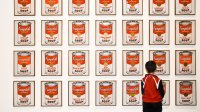Pythagoras and Picasso: Integrating Math and Art in the Classroom
Here are seven ways teachers can use works by Pablo Picasso, Andy Warhol, and other artists to teach elementary and middle school math.
Your content has been saved!
Go to My Saved Content.Pablo Picasso once said, “Every child is an artist.” If that’s the case, shouldn’t our students be afforded opportunities to create art in their daily lives? Arts integration is possible in all subject areas and can yield the multimodal, engaging activities students crave. Multimodal experiences can also activate the higher levels of Bloom’s Taxonomy and foster synaptogenesis.
I focus here on the integration of visual arts with mathematics. Let’s explore seven activities that would make Pythagoras smile.
Art for math’s sake
Andy Warhol–inspired multiplication arrays: In this project, show your students examples of Andy Warhol’s pop art, such as his Marilyn Monroe or Campbell’s Soup can pieces. Discuss the multiplication problems depicted in Warhol’s work. For example, in the Marilyn Monroe piece on display at the Cleveland Museum of Art, the array would depict the multiplication problem 20 x 5 = 100. There are 20 images of Monroe across and five images down. Then, challenge your students to create their own array with an image of their choosing. After they complete the arrays, have students share them with each other and explain their arrays and corresponding equations.
When I taught this project, I had my students create their work by hand with paper and coloring supplies; however, this could certainly be done in an online format with software like Canva. Students can share their work orally, in person, or virtually through Flip or Seesaw. My students had a blast creating and sharing their array artwork, and it brought mathematics to life for them. This project was authentic and helped students make real-world connections.
Shape hunts with images of famous works of art: This is a fun activity for students of any age and works great as a hook for a lesson. Look for images of famous works of art on Google or on the websites of art museums such as the Metropolitan Museum of Art, the Louvre, and the Cleveland Museum of Art. Find some of your favorite pieces and put them in a slide show for students to view. Have students discuss the various shapes that they see with the whole group, in small groups, or with a think-pair-share method. For example, my students have noted the crescent in van Gogh’s The Starry Night painting.
Symmetry of nature photography: Another fun way to integrate visual arts and mathematics is through nature photography. This can be photography from the internet or photography shot by your students with iPads or mobile devices. Have students view and analyze the symmetry, or lack thereof, in the photos. This activity could lend itself to a choice board activity, a whole group activity, or an extension activity after a unit on symmetry. A possible extension activity for this project itself could be compiling a class book of symmetry found in student-taken nature photography.
Analyzing patterns through art: Patterns are everywhere in the world around us, and teaching students this problem-solving skill is vital to their 21st-century skill development. By showing students designs, prints, and images made with various colors, shapes, and textures from the internet or by local artists, you can facilitate opportunities for students to discuss their findings and engage in metacognition. An added layer to this arts-integrated mathematics lesson would be having students create patterns for their peers to analyze.
Shape art gallery project-based learning (PBL): This is a project that I used with my elementary school students and borrowed from PBLWorks. After teaching my students about two- and three- dimensional shapes, I had them sketch items they saw in my classroom and around the school in their notebooks. Then, my students re-created their sketches with art supplies like construction paper, stickers, coloring supplies, and pipe cleaners. After they made their art, my students acted as artists in a museum to tell their peers about the work and the shapes found within it.
Geometry and area/perimeter zoo PBL: My students enjoyed this unit after learning about how to calculate areas and perimeters and reviewed two-dimensional shapes. They used graph paper to design and draw their own zoo maps. I asked them to create exhibits on their maps for any animals they wanted to, but they had to include an exhibit that looked like each of the following shapes: circle, square, rectangle, hexagon, rhombus, and triangle. We talked about all of those shapes in the geometry unit. Then, the students had to calculate the areas and perimeters of each exhibit on the map and label it accordingly. On the due date of the project, my students shared their zoo maps with their peers and other adults from around the school.
One-to-one correspondence with Picasso and Mondrian: One of the building blocks of mathematics is counting and one-to-one correspondence. Without this skill, students wouldn’t be able to successfully execute other mathematical operations. The concept of one-to-one correspondence could be reinforced with shapes, colors, and visual arts. I chose to use works by Picasso and Mondrian for my lessons, but any artist’s work could be used to count shapes and colors.
Picasso and Mondrian are two artists who used lots of shapes in their artwork; Picasso has numerous facial features to count, and Mondrian uses many rectangles and squares. Have students count the different shapes in previously selected works by these two artists. Then students can record their responses and even graph the number of shapes in the artwork.
The above ideas hopefully will be stepping stones for you to design meaningful, relevant, and intentional arts-integrated mathematics lessons and activities for your students. Some additional technology resources to use include Google Arts & Culture, Google Drawings, PBS LearningMedia, The Kennedy Center, and generative AI such as Google Gemini, ChatGPT, or MagicSchool AI.
